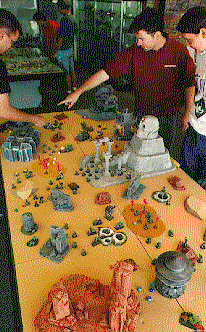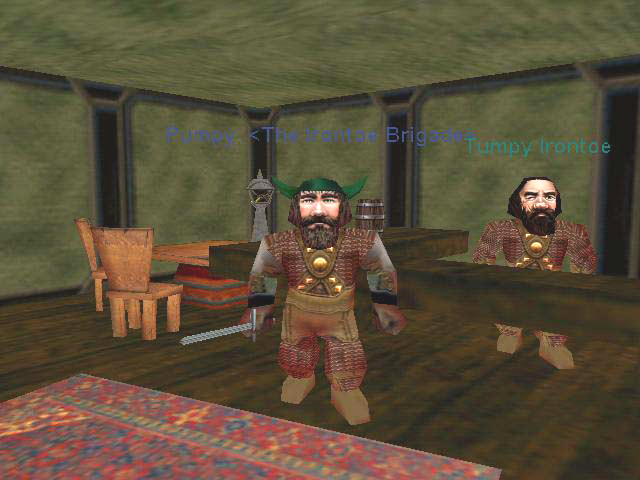In the early days of EverQuest, a cheater and designer waged a secret war from a San Diego gaming store
One of New World's key developers actually got his start by breaking EverQuest.

It's the year 2000. We've managed to avoid technical annihilation at the hands of the Y2K bug, Tina Fey and Seth Meyers are helping SNL still be funny, and somehow every mall has decided that we should all be listening to Creed (shudder). But game developer Geoffrey "GZ" Zatkin wasn't at the movie theater watching Remember the Titans—he was standing in legendary San Diego game shop Game Empire watching people play his team's brand new MMO. That game was EverQuest.
But some people weren't just playing Everquest—they were breaking it in half.
EverQuest was an experimental game in every sense of the word
Why would a developer go to a game shop to work on his game instead of staying at the studio? There were no gaming laptops. No one had wi-fi. Remote work as we know it certainly didn't exist yet.
"Our dev tools at the time were prehistoric!" laughs Zatkin today. EverQuest was the first 3D MMO ever. Resources were tight, the team was small, and they were sailing into uncharted waters without a map. With a custom-built game engine and no development time anywhere in sight to build reporting tools, if Zatkin wanted to observe players and see how his systems were working, he had to load into a GM character, cast a super invisibility spell on himself, teleport to the zone and stand around while they fought monsters.
EverQuest was an experimental game in every sense of the word, and everyone on the small team working on it wore many hats. One of the hats GZ wore was designing the magic system top to bottom. "Brad [McQuaid, producer] came by at one point and was like 'hey Geoff how many spells are we up to?' I said 450 and he just stopped. He'd been expecting like 50." So in looking for a way to observe players, using the magic system came naturally. Most of Everquest's GM powers ended up being spells that Zatkin designed.
He liked to have fun with the spells, too. A popular early website with information about EQ was Caster's Realm, run by an Australian named Greg Short. One of the site's biggest draws was a detailed list of the game's spells. They got a lot of this information by scraping beta server patch notes, which was not without some risk. "One year, right around April 1, I put up a patch to beta where I nerfed the most popular spell of every class except one, whose signature spell I buffed," GZ says. "I just put it up with no notes as a friendly reminder that what went to beta was for testing. It's the only time I've ever been called at 1am by my boss. Brad called me up and went 'the forums are on fire, what did you DO?'"

With EverQuest blowing expectations out of the water and becoming a worldwide phenomenon (so much so that they overloaded the service provider and crashed the internet for large swathes of San Diego for a week), GZ needed a better way to understand how his players were playing. Game Empire provided just such an opportunity. With computers set up to be rented hourly and a cable connection, it was like a proto internet café. And the shop was full of Pro Tour Magic players, Warhammer 40K tournament champions, and future game developers—lots of whom were obsessed with EQ.
Keep up to date with the most important stories and the best deals, as picked by the PC Gamer team.
One of those players was David Fay. David was a Warhammer guy and former Ultima Online player who helped convince the store owner to install EverQuest on all his machines. Fay was able to transfer his skills finding the optimal army composition or Magic deck or UO crafting strategy to a new game—one with way more players.

At the time almost no one had a setup at home to run multiple characters at once. Computers were expensive, we still paid for internet by the hour, and the time it took to level up a character in EverQuest was preposterous. Information was scarce as well: apart from a few fansites (and an embarrassingly bad player's guide), no one knew which quests gave good experience, where to farm platinum pieces, or what your spells did until you bought them from the vendor.
All of this combined to make the game shop the perfect situation for players looking for an edge. With lots of high-skill gamers, eight (!) computers all within literal arm's reach, and the ability to actually talk with one another in meatspace (we're a couple years before Teamspeak here, let alone Discord), Fay and others like him were able to find some pretty great strategies. Strategies that, unbeknownst to them, were being watched over their shoulders by one of the guys who wrote them.
One was for a little-known quest that involved a thirsty dwarf and a liquor called Tumpy tonic. By going from the dwarf capital of Kaladim to the Ocean of Tears, you could buy some Kiola nuts from a friendly elf. Once you waited for the boat again and returned to the dwarven homestead (a round trip that took well over an hour), you could give the nut and a flask of water to the man, the myth, the legend himself—Tumpy Irontoe—and receive a flask of his tonic. Then you took that brew back to the thirsty dwarf in Freeport (another hour), handed it in, and got a bit of cash and some experience.

Or you could do what David Fay did and set up a syndicate.
"I recruited all the local guild members—we had multiple master tailors making bags, six people doing port runs to go get nuts so we can avoid the boat ride, four master brewers standing at the brewing stations, and knew exactly when the guy would spawn so we could turn it all in," Fay says. To this day he's still proud of the scheme. Their operation was so successful they eventually started turning extra profits and selling fully leveled characters on eBay.
Players on every server were making beer runs across the Ocean of Tears, and the devs had gotten wise
At the time it was the wild west for digital objects: eBay and other sites hadn't started policing digital transactions yet, and developers were way behind the ball. An associate professor of economics at Cal State Fullerton wrote a paper in which he came to the conclusions that the GNP (gross national product) of EverQuest was somewhere between Russia and Bulgaria and that the EverQuest platinum piece was worth more than the Japanese yen or the Turkish lira.
Fay's operation was slick, but it didn't last long. A month or two of long days farming tonics later, word had gotten out. Players on every server were making beer runs across the Ocean of Tears, and the devs had gotten wise—in no small part due to GZ's… reconnaissance.
"GMs started showing up and nuking the quest guy!" Fay says ruefully. He changed his sleep pattern to operate while the service staff were asleep, but even that was not enough. Eventually they brought down all servers, and when they came back up an hour later the patch notes only had one line:
"The Tumpy Tonics quest has been removed."
The cat and mouse game would continue unabated for months. Binding a shadowknight in the arena in Kael and killing frost giants by deathlooping harm touches (arena death meant PvP death meant no XP loss in those days!), maxing people's combat skills by exploiting duels with charmed pets, and no shortage of other shenanigans were hotfixed by the watchful developers.
Eventually, though, the schemer and the scheme-blocker became friends. Bonding over a shared love of Warhammer 40K, EverQuest, and other things geeky, David and Geoff started spending more time with one another. And then Fay finally learned where Zatkin worked. "I remember it was months later and Geoff invited me to a LAN party at his work. We drove over and it was at SOE," he says.
Brutal.
Fay's love of game systems stayed with him even after his EverQuest schemes dried up. When Geoff Zatkin broke off from game development 10 years later and started a data business called EEDAR with Greg Short from the fansite Caster’s Realm, he knew just who to bring on the team. "Because David was so good at dissecting things from EverQuest, he was a very easy choice for our first hire to analyze games," GZ says. EEDAR became the leading market research firm for video games and was later acquired by NPD in 2016.
Eventually David found himself on the other side of the screen. In 2017, he joined Amazon Game Studios and worked on New World as a senior game designer and product management lead up through the MMO's launch. More than 15 years after his shenanigans at Game Empire, he needed to fortify his project against the kinds of attacks he was once famous for. Using the same mindset he applied to Tumpy tonics, he worked with alpha players to find weaknesses in the game's systems and economy.
"It's taking what you know as a player, what you've seen happen, what you've done before and taking what you've learned about running a business and leading teams and merging it together," he says. A lot's changed since EverQuest's heyday, but staying ahead of players remains an impossible challenge.
Russ has been playing PC games since the top of the line graphics were in ASCII and has been obsessed with them just about as long. After a coordinated influence campaign to bamboozle his parents into getting a high speed internet connection to play EverQuest, his fate was well and truly sealed. When he's not writing about videogames, he's teaching karate, cooking an overly complicated dish, or attempting to raise his daughter with a well rounded classical education (Civilization, Doom, and Baldur's Gate, of course). He's probably mapping in Path of Exile right now.

